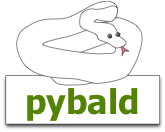Templates¶
The pybald web framework uses Mako templates by default for rendering content.
Setting up templates¶
Pybald uses mako template files. By default, the template_path is defined as app/views. We’re going to override the default path that pybald normally looks for template files for our simple example app. Let’s update our small example pybald app to include the template_path configuration directive and set it to the root path of the project. Where we call pybald.configure we’ll add template_path=".".
# configure our pybald application
pybald.configure(debug=True, template_path=".")
Once we’ve done this, pybald will know to look for template files in the same path as the root application.
Your first template¶
Lets create a template file and call it home.html.template. This will be an html template to generate content for our application. In this file, lets add the following content and save the file. This isn’t terribly exciting for now, but we’ll show more of the power of templates later.
<html>
<head></head>
<body>
<h1>Hello world!</h1>
</body>
</html>
Now let’s render this template. Let’s go ahead and start up our console again using python sample.py console. We’ll import the pybald context and then use the render function in the current context.
Route name Methods Path
home /
Welcome to the Pybald interactive console
** project: sample.py **
>>> from pybald import context
>>> content = context.render("home.html.template")
Using template: home.html.template
Rendering template
>>>
>>> print content
<html>
<head></head>
<body>
<h1>Hello world!</h1>
</body>
</html>
We’ve just rendered a simple template to a string.
The reason we use the context is because the template system needs to have a certain amount of configuration to run correctly and the context represents the current configuration. For example, the template system needs to know where to look for the template files and what template filters to apply (described later).
Using the template in a request¶
We’ve just rendered a template, but we got a string value back, how do we use the results in our web requests? The answer is simple: we just return that string from one of our actions.
We can update our sample application to return the rendered template.
import pybald
from pybald import context
from pybald.core.controllers import Controller, action
from pybald.core.router import Router
# configure our pybald application
pybald.configure(debug=True, template_path=".")
def map(urls):
urls.connect('home', r'/', controller='home')
class HomeController(Controller):
@action
def index(self, req):
return context.render("home")
# this is the WSGI pipeline
app = Router(routes=map, controllers=Controller.registry)
if __name__ == "__main__":
context.start(app)
Now we can run our application and initiate a simulated web request as before, only this time we’ll return the results of a template render.
Route name Methods Path
home /
Welcome to the Pybald interactive console
** project: sample.py **
>>> resp = c.get("/")
====================================== / ======================================
Method: GET
action: index
controller: home
Using template: /home.html.template
Rendering template
>>> print resp
200 OK
Content-Type: text/html; charset=utf-8
Content-Length: 65
<html>
<head></head>
<body>
<h1>Hello world!</h1>
</body>
</html>
You’ll notice that in this example we’ve just used "home" for the argument to context.render. This is one of the conveinience behaviors of pybald, the default file extension for html templates is .html.template so you don’t have to explicitly use the full filename.
Using data in templates¶
Now lets do something interesting with the template. Templates allow us to bind data to them and use them to create variables and execute template logic.
First lets update the template to create a placeholder, a variable. The syntax to add an expression in Mako is ${} so below we’ve added a variable ${name} to the template.
<html>
<head></head>
<body>
<h1>Hello world!</h1>
<h2>Greetings to ${name}</h2>
</body>
</html>
If we attempt to render this template, we’ll get a surprise.
